What It Takes to Make Money Selling Online Courses

Introduction
Hi there. First of all, head’s up: this is a long post. It’s about the length of an average chapter in a non-fiction book. If you’d rather print this out and read it on paper, which I would do myself, you can download a pdf ebook version of this post at the bottom of the page.
Secondly, take your time with this. If you’re new to the idea of building a business and revenue stream from selling your knowledge online with products like an online course, it can feel overwhelming to realize how much work is involved in making that dream a reality.
I do NOT want you to feel overwhelmed, but I also don’t want you to jump into the journey of building a business like this without knowing what’s coming ahead of you. That’s the main reason I wrote this post (and the ebook version of it.)
Here’s the other reason I wrote it: I do the things I do in Clarity Lab, like writing this ebook, to help you find more freedom and less suffering in life as a result of you building a successful online business that makes money from you selling your knowledge.
If I can help you do that, you and your family will have a happier, more enjoyable, fulfilling life. And that? Will make me happier.
Before I started learning how to make money online by selling my knowledge, I struggled (hard) to figure out a way to earn good money. I know this kind of pain. Intimately.
I was living up in the mountains outside of Boulder, CO making only $7,000 a year and eating canned corn for dinner. That was rough.
I would often wander around the woods searching the ground around the old gold mines and streams for a gold nugget.
I thought that if I could just find a good sized gold nugget, I could get out of the financial hole I was in. LOL.
I never found that big gold nugget out in the woods. But I did something better. I forged my own gold nugget. It’s made out of the knowledge I’ve learned about how to create a thriving online business by teaching people to make a positive change in their life.
THAT gold nugget of knowledge is what I want YOU to have.
No one can take that kind of gold nugget away you.
If you have this kind of knowledge, and if for some reason you lost your home, your computer, and all the money in your bank accounts, you’d still be okay.
You could borrow a friend’s laptop for a while and start over from scratch, building a new business that would support you and your family. You would have a gold nugget of knowledge about how to make money online, and no one could take it away from you.
That is true income security. It’s financial peace of mind. And I want that for you.
That’s why I do what I do at Clarity Lab, and that’s why I wrote this ebook for you.
Alright, let’s dive in…
Your Opportunity
If you have knowledge that can help a community of people change their lives for the better, you can create an online engine that will deposit money into your bank account.
I know that might sound a bit smarmy, like the kind of over-the-top promises some internet marketers will put at the top of their sale pages in giant red letters, but, I mean it…and it’s true.
Teaching online to people who want to learn from you can feel like you’ve created a money printing machine for yourself.
In exchange for the money you can make from teaching, you’ll make a positive difference in your customer’s lives.
This is a business engine you can run from a laptop with an internet connection. It’s an engine that would allow you to leave your current job (if that’s a goal), or to stop selling your hours for money by doing client sessions (if you’re getting tired of that), or simply add another revenue stream to your existing business.
If you’re reading this, you’re likely aware of this potential already. Unless you’re really good at ignoring all of the ads on Facebook for courses on how to build a business like this, you’ve already gotten wind of what’s possible in this arena.
Maybe you’ve also heard that when some of the bigger online gurus launch their programs, they can make $4 or $5 million dollars in a matter of weeks.
While that does in fact happen, I don’t know about you, but when I hear those numbers it feels about as realistic as winning the lottery.
Maybe that’s because I haven’t had a million dollar launch yet. I’ve had several launches of online courses above the 6-figure mark though, and my wife and I have done many launches that brought in mid six-figure range (gross, not net). I’m not bragging. I’m telling you that to give you a sense of what’s possible. This is no joke, you guys. This kind of income is possible.
The trail between where you might be now and making that kind of money is not an easy one, nor is it a fast trail to travel, but it’s a trail you can travel. It’s possible, and your chances of succeeding are far greater than winning the lottery.
Over the last three years alone, I’ve had over 350 one-on-one consulting sessions with people just like you and me. People who want to make a positive impact in the world by teaching what they know to a community of people that have a problem they can help solve.
Through all those conversations, it’s hard not to notice patterns. Despite the amount of information available online, both free and paid content, the most obvious pattern I’ve seen is that folks don’t know the full picture of what it takes to build a sustainable business that sells knowledge products (like online courses.)
Most people know bits and pieces of the full map, such as knowing they need a website, or thinking that the only thing they need to do is post things on social media about their courses, but I’ve only come across 2 people in those 350 consulting calls that had the full map of the territory in their bag.
And there’s more to it than most course instructors will tell you, even when they’re teaching you how to build a business like this.
There are some great courses on this topic out there. Don’t get me wrong. But after seeing what they cover inside their lesson content, many courses still leave large knowledge gaps.
Knowledge gaps create questions in learners. Questions cause people to move much more slowly on the path of building their business. And often, when it takes people too long to get enough money coming in from their new business, they have to abandon their quest. So, I’m not a fan of knowledge gaps or incomplete maps. I want to see you get to your destination as soon as possible.
And this destination? Is unfortunately not one you can type into Google Maps and get directions to. There just aren’t any good maps of this territory out there, at least, until now.
For the last 12 years, I’ve been out in this unmapped territory trying to figure out the best route to get to my destination: a place where I’m no longer stressed out about money every single day.
A place where I have freedom to create the kind of work I want to do, to help the people I want to help, to work the amount of hours I want to work, and have enough time to spend with my wife and son. A place where, for better or worse, I’m the one making decisions about which direction to head in next on this adventure.
I’ve had some successes along the way and I’ve made some big mistakes as well. During this 12 year quest, I’ve worked on mapping out this territory, and here, in this ebook, I want to share my map with you.
The purpose of this map is to give you clarity around what the territory ahead of you looks like; to give you a full view of what it takes to build an online business that helps people you want to help by teaching your passion.
Right now, it’s in the format of a mind map. When it’s fully expanded, you can’t see much detail, given the size of it. So, I’ll first show you an unexpanded view of the map, then we’ll zoom in to different parts of it and give you a tour through each part of the map.
The Online Knowledge Business Map
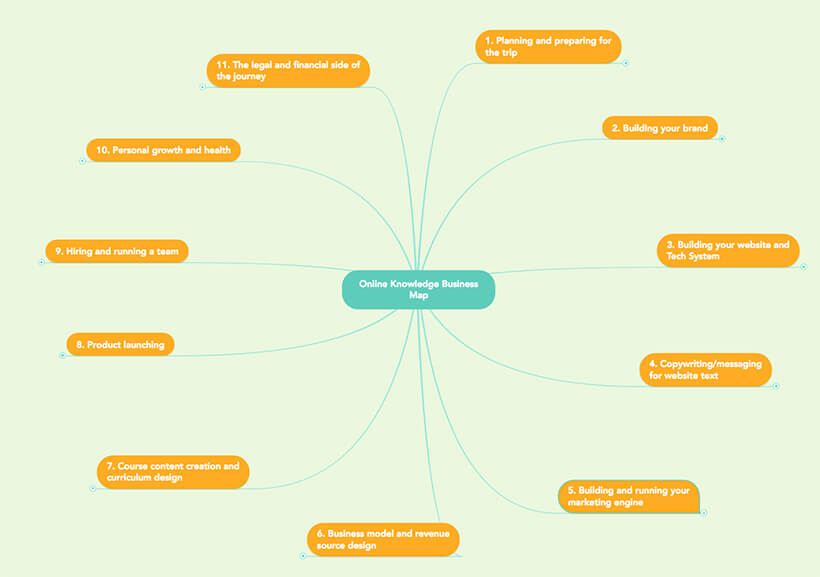
Right. Like I said…it’s a large map, so when you look at a zoomed out view of even just the large areas of the map (in orange), it’s hard to see any detail.
What you’re looking at though are 10 major areas that you’ll need to travel to on the trip to your destination.
Keep in mind that this is just a map. It’s an overview of the territory and it answers the question “What’s ahead for me on this journey?”
The how of how to get from one place on this map to another, or how to accomplish things in any one of these towns or cities, wouldn’t fit in one ebook. It would take an entire course with many modules and lessons to explain the many ways to make this journey. (And yes, I’m working on that course 🙂
Okay…here are the 11 areas on the map, in readable text:
- Planning and preparing for the trip.
- Building your brand.
- Building your website and Tech System.
- Copywriting/messaging for website text.
- Building and running your marketing engine.
- Business model and revenue source design.
- Course content creation and curriculum design.
- Product launching.
- Hiring and running a team.
- Personal growth and health.
In general, places one through five on the map are places you’ll need to travel to in that order, if you want to make your trip easier. (As long as I’m using this map metaphor, I might as well call these places “cities and towns” If I was better at using Photoshop, I’d create you a cool map with cities and towns on it. But I’m not, so, a mind map will have to do for now.)
Once you get to the place where you start building your marketing engine, though, where you go next on your journey will be based on the decisions you make, like those Choose Your Own Adventure books.
Of course, you can travel to these places on the map in any order you like. As your guide, though, I’m just saying that your journey will be A LOT easier and more rewarding if you go to the first five places on the map in order.
What happens when you try to go on this journey in a different order, or when you skip going to certain towns or cities altogether? Well, for example, I talk to a lot of folks in consulting calls (both the free discovery calls I do and paid calls), who start in the Course Creation town first, then go to the Tech System city, skipping Planning Town and Brand Village altogether. (Doing this will cause a lot of problems for you on your quest, so I’d advise against that route.)
Alright. Let’s take a high-level overview tour through the cities and towns on this map…
First Things First
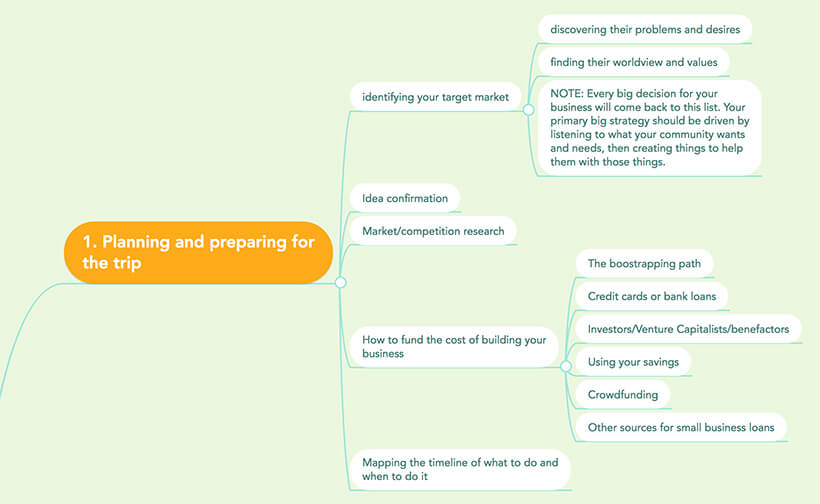
I can’t tell you how many times I’ve met someone, or watched someone, work their ass off for 6 or 9 months to build a new website, tech system, and product launch for a course they’ve created. Then they launch their course and sell one or two seats in it, or…none at all.
They spend tens of thousands of dollars on graphic designers, copywriters, tech people, and videographers. Hopes run high, and the course owners are sure that they will sell hundreds or thousands of spots in their online course. But when they launch it? Crickets.
It’s demoralizing for them and so, so hard to see happen to someone.
The same reason that it’s hard to build a business like this is the same reason it’s hard to analyze why an online course launch didn’t go well: there are a lot of pieces to get in place, and each of them has to be done exceptionally well.
When I help clients analyze why a launch didn’t go well, or, why their whole online business isn’t doing well, the first place I look is to see how clear a business owner is on who they are trying to help and what they’re trying to help them with.
This is the “identifying your target market” bit in the map above.
It’s imperative that you know who you want to help, what they want, what they’re struggling with, what they’re super frustrated by, how they view the world, how they think, feel, and talk to themselves about the world they see, what they’re willing to pay for, and how you can help them.
You’ll be faced with countless decisions within your business every week. Your business will have a much greater chance of succeeding in helping your audience and generating sustainable revenue for you if you base everything on what your audience wants and needs from you.
Think of this as an “audience first” strategy. “Audience” isn’t the warmest of words, so if that doesn’t work, you can try “people first,” your people…the people you want to help with your knowledge.
If you want to avoid The Horrible Place, you need to know who the people are that you want to help. You need to know what they want. And you need to confirm with people in this community that what you want to sell to them is something they’re willing to pay for.
Not doing those three pieces of the planning process is what gets most people into trouble when they launch an online course that few, if any, people buy.
Building Your Brand

If you’ve identified a niche community, found something pressing they need that you can help them with, and confirmed that people in that community are interested in buying what you want to sell, the next step is to start building your brand.
Your brand is much more than your logo, or the color palette on your website, though you’ll need those things too.
Your brand is how people in your audience feel when they interact with any part of your business (like your website, your emails, or customer support emails.)
You’ll need the basics in place as part of your brand feeling:
- A business name that isn’t being used by anyone else A domain name that’s easy to remember and share verbally
- A logo (start with a simple, inexpensive typeface logo with no graphic art in it)
- A designer to help you create these things if you can’t make them on your own.
- A color palette and brand style guide to create consistent imagery across the web for your business, like on social media.
Though all of those things are important and definitely play a part in creating the feeling of your business, the words you use on your website, whether those words are in text, videos, or audio recordings, will create a much bigger impact on the feeling of your brand within your prospects and customers.
It’s at this stage of the journey where it’s helpful to start thinking about how you want your business to be expressed in terms of the personality, or voice, that will come across in the words on your site, or in emails you send out.
That will lay the foundation for what’s to come a couple steps down the trail.
Building Your Website and Tech System
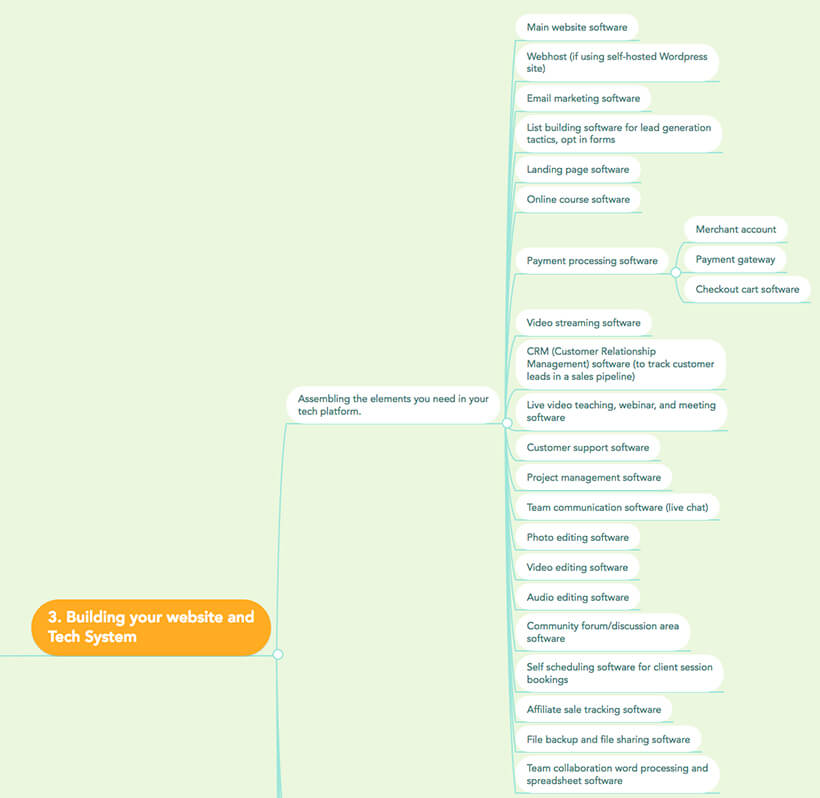
There’s quite a lot in this next step, so I’ll need to show you in two different images.
Because of the number of things in this section of the tech system part of the journey, it makes the text quite small when I fit them all in the snapshot of this part of the map.
So, I’ll list them out below as well so they’re easier to read.
At this point of the journey, you won’t be able to get much else done until you have a website, but the website is just one part of the full online tech system you’ll need to run a business that sells knowledge products online.
Depending on your short terms plan for building your business, marketing your products and services, and launching your course, you may or may not need all of the apps, or pieces of software, on this list all at once.
Which ones are necessary, and at what point you need them, depends on how you approach getting your business off the ground and towards a place where you can launch an online program
At a minimum, though, you’ll need a website with a home page, about page, a blog page, a contact page, and a sales page for your services and online course (or other digital products you might sell, like ebooks.)
In addition, you’ll need a way to start building your email list, which means you’ll need your website to be able to have opt in forms so people can sign up for free things on your site (like a free ebook, a free video course, or a free 7-day email course.)
And your opt in forms need to be able to integrate with your email marketing software, which you’ll need in order to store your email list of contacts and send out either autoresponder emails (for things like a free email course), or broadcast emails that you send out manually (like an email to announce a new blog post or podcast that you’ve just published.)
Those are the things from the list below that will be a minimum amount of apps or software you’ll need to get things going. As you get closer to preparing your course content and launching your course, you’ll need more things from this list.
The Necessary Components of Your Tech System
One last word of advice: don’t get overwhelmed by this list. Remember, you won’t need all of this at once to get started. And if you already have some of these things in place, you won’t need all the rest of them to do what you want to do next with your business. You may just need one or two more pieces of software for the next few steps of your plan.
It’s one thing at a time, and, if an “all-in-one” app, like Kajabi could work for your business, you can get around 8 of these web apps built into one platform, which can greatly simplify your tech platform, your business, and your life as a whole. (If you want to get a tour of what Kajabi is like to use, and see why it’s my top favorite all-in-one app for people building an online business that sells digital knowledge products like online courses, you can read my in-depth, no holds barred review of Kajabi right here.)
Here’s the list of categories of the types of software you’ll need to build the revenue engine you want to build:
- Main website software
- Webhost (if using a self-hosted WordPress site)
- Email marketing software
- List building software for lead generation tactics, opt in forms
- Landing page software
- Online course software
- Payment processing software
- Video streaming software
- CRM (Customer Relationship Management) software (to track customer leads in a sales pipeline)
- Live video teaching, webinar, and meeting software Customer support software
- Project management software
- Team communication software (live chat)
- Photo editing software
- Video editing software
- Audio editing software
- Community forum/discussion area software
- Self scheduling software for client session bookings
- Affiliate sale tracking software
- File backup and file sharing software
- Team collaboration word processing and spreadsheet software
Building Your Tech System, Part 2
Whoa! Okay. I know that list sounds like a lot. Stick with me though. Like I said above, you most likely WILL NOT need all of those kinds of software all at once to get started. The goal is to start with the minimum amount of software you need to start making money and helping people.
If you already have a business up and running with many pieces of those types of software listed above, the goal for your next phase of growth is to just add in the minimum amount of apps you’ll need to accomplish your next goals.
Now, with that list above, within each category of the kind of software you’ll need, there are often between 5 and 25 options for apps you could use for any given category.
Multiply that by the number categories I just listed, and you’re suddenly faced with a dizzying array of confusing tech options.
So, the first big challenge you’ll face in Tech City is deciding what apps to use, which involves figuring out which apps integrate with which other apps. This is one of the first places on the journey where large frustration can start to come up. Just be aware of that and keep breathing through it if it starts to happen for you.
And know that I can guide you through this part of the journey to minimize the frustration and get you to a place where you have a website and tech system up and running as quickly and inexpensively as possible.
Whoa! Okay. I know that list sounds like a lot. Stick with me though. Like I said above, you most likely WILL NOT need all of those kinds of software all at once to get started. The goal is to start with the minimum amount of software you need to start making money and helping people.
If you already have a business up and running with many pieces of those types of software listed above, the goal for your next phase of growth is to just add in the minimum amount of apps you’ll need to accomplish your next goals.
Now, with that list above, within each category of the kind of software you’ll need, there are often between 5 and 25 options for apps you could use for any given category.
Multiply that by the number categories I just listed, and you’re suddenly faced with a dizzying array of confusing tech options.
So, the first big challenge you’ll face in Tech City is deciding what apps to use, which involves figuring out which apps integrate with which other apps. This is one of the first places on the journey where large frustration can start to come up. Just be aware of that and keep breathing through it if it starts to happen for you.
And know that I can guide you through this part of the journey to minimize the frustration and get you to a place where you have a website and tech system up and running as quickly and inexpensively as possible.
For now, just keep in mind that sorting out what apps to use gets a little tangly when it comes to the part where you try and figure out what apps will work with what other apps.
For example, your online course software needs to integrate with your payment processing software, and those things need to be able to integrate with your email marketing software.
Without tight integration, you won’t be able to automate things that should, or can, be automated. And without automation, you’ll have a very hard time growing your business with a small team, and an even harder time if you’re building and running it solo for a while.
Deciding on what apps to use for a new or already existing business can be hard, and rather time consuming. If you’d like help, you and I can hop on a call and talk about how I can help you sort out the tech decisions quickly. (If that sounds interesting, you can learn more about it right over here.)
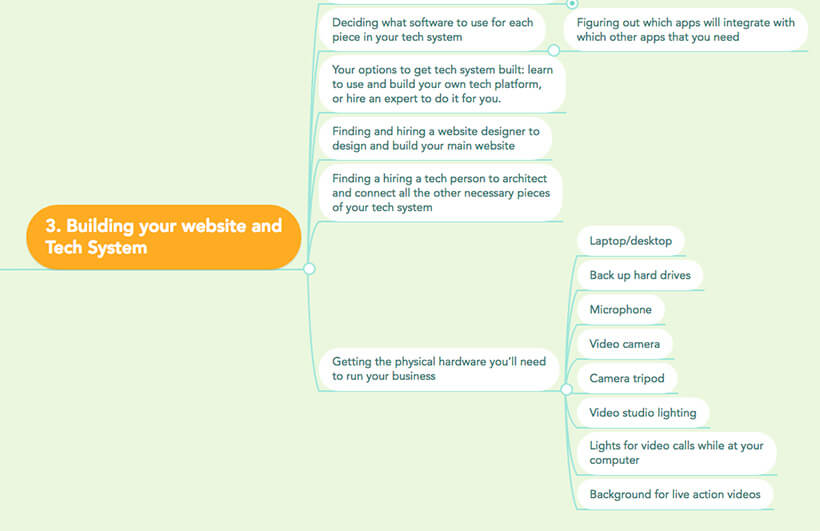
Once you get past the challenge of sorting out what software to use, the next challenge you’ll face in Tech City is “who the heck is going to set all of this up?”
Your options for getting this done are going to be the same options you’ll have for any part of building your business that I’m discussing in this map:
You can learn to do this yourself and get it done on your own. (A good, and smart, option if you have more time than money.)
You can hire an expert to do it for you. (A good option if you have the money to hire someone and you don’t want to spend the time to learn how to do it yourself.)
You are fortunate enough to have a spouse or family member who is able and willing to do this for you to help you grow your business. (This happens more often than you might think.)
The same goes for keeping your tech system updated and running well after it’s built, as well as for any graphic design involved in creating your website.
And depending on what kinds of content you’ll create for your free and paid content, you’ll need some, or all, of the list of physical equipment shown in that part of the map above.
If you’re new to the idea of creating a business like this, and you’re new to the technology required to make it all happen, all of this tech stuff will likely feel a bit overwhelming, confusing, and hard.
It is all of those things, but only at first. It gets much, much easier once you get familiar with each piece of your tech stack (the combination of apps you’ll use on a daily basis to run your business.)
And in the larger context of the whole journey of traveling to each of the towns and cities on this map to get to your destination, the challenges you’ll face in the tech realm are the easiest challenges to solve.
That’s just a friendly reality check so that you know that going on this journey isn’t exactly easy. If it was easy, though, you’d have a lot more competition to deal with. So you’ve got that going for you, which is nice.
Copywriting
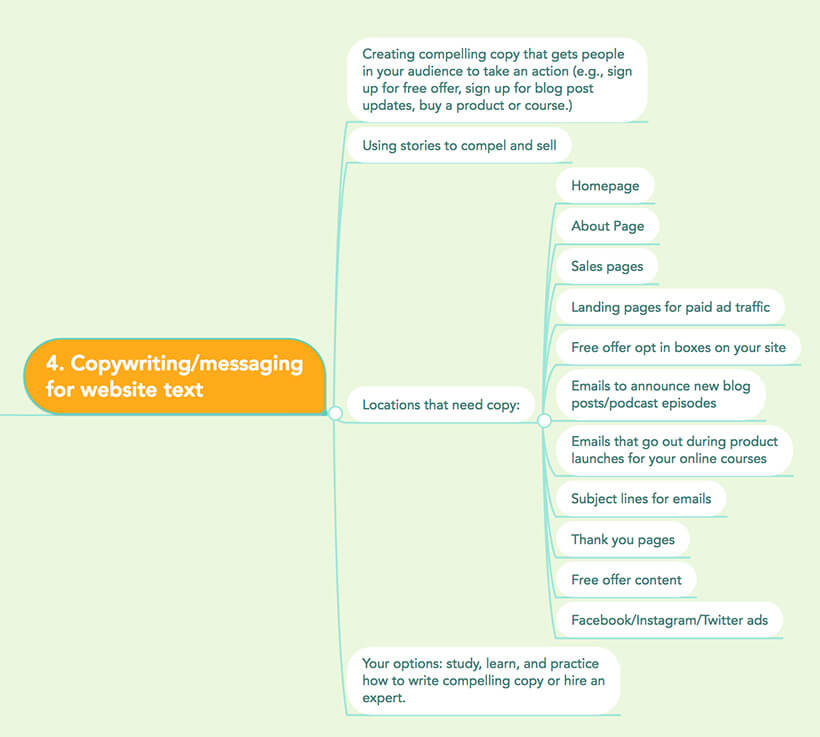
Okay, onward! If the word “copywriting” doesn’t make sense to you, I define it as any words that are designed to get someone in your audience to take an action.
That action could be to sign up for a free 7-day email course, to click on a “learn more” button on your homepage, to opt in for a free video course on your About page, to click on a link in an email, or to buy your online course from a long form sales page, to give just a few examples.
Remember in the first step on this journey I mentioned that it is so incredibly important to get extremely clear about who you want to sell your products, courses, or services to? Well, crafting compelling copywriting is one of the most important reasons to know the worldview and problems your people have.
Knowing how they see the world and how they think about the problems they have (problems you can help them with) allows you to create words on your website, whether they are in text, in videos, or in audio recordings, that will resonate emotionally with them.
People take actions based on their emotions, then seconds or minutes later, will justify their decision with their logical mind.
Resonating emotionally with people in your target audience with the words you use is the key to making your journey successful.
Copywriting is hard though. Like, really hard. It’s a science and an art and takes years to perfect. I find it fascinating so I study and practice it, but unless you’re willing to invest in a really good online course about copywriting, and unless you have time to study and practice it, by far, the best option for you would be to find and hire a talented, professional copywriter.
They won’t be cheap, but the return on your investment with a good copywriter is one of the best you’ll ever see with anything you spend money on to build your business.
Having the right messaging on your site, in your Facebook ads, and in your emails can be the difference between you making your dream a reality, or having the journey end in The Horrible Place.
Your words matter more than you can imagine. Early on in your journey, you’ll need to spend some time in Copywriting Town. Seriously…don’t skip it.
Your Marketing Engine
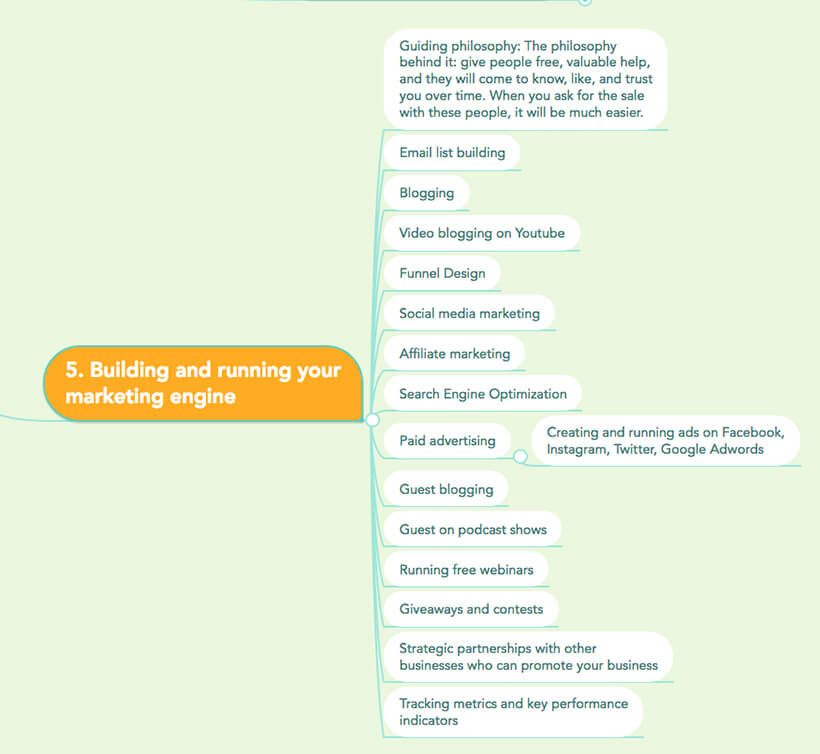
There are a lot of definitions of marketing on the web. I think of it as the process of discovering what your market wants help with, creating something they’re willing to pay for in order to get that help, getting the word out about what you have for them, and selling them your product, service, or course.
The first stage of this journey that I outlined above, then, is a crucial step in your marketing strategy. You must know who you’re trying to help and what they want help with, and you have to deeply understand how they see and think about the world around them. (And yes, I know I keep repeating this bit about knowing your audience. It’s super important, though, and so many people don’t clearly define who their products or services are for.)
This part of the journey is focused on the part of marketing you may be more familiar with: ways to get the word out about your business and what you offer.
Most of the things on the list in the map above are various ways to do content marketing, which is the process of giving away free useful, helpful, or entertaining content that will help your tribe with the same problems that your paid content will help them with.
I don’t like the phrase “content marketing” much, though. Yes, we use our “content” to help people with problems, which helps get the word out about our work in the world, but “content” always feels so generic to me. I think of a black and white can of beer that just says “BEER” on the side of it when I hear the phrase “content marketing.”
What you’re reading now it free, helpful “content,” but what’s really in pieces of content that you share with your tribe? They’re full of useful ideas, or concepts, that can help you make a change in your life.
“Content” is trying to name the category of things like free blog posts, ebooks, podcasts, or videos. We can’t really call them “ideas,” or “concepts.” They’re all subject matter though, so why not call them all “matter.” So then, we’re doing “matter marketing.”
There are many ways to use your subject matter to market your products and services. Blog posts, video posts on youtube and on your own site, free offers like ebooks or email courses, podcast episodes, guest blog posts, guest interviews on other people’s podcast shows, mini posts on social media, and online webinars.
The goal with putting out free content matter, no matter what media format or location on the interweb that you put it on, is to get as many people to your website as possible, and then, most importantly, onto your email list.
Why? Because building a relationship over time with people by sending them regular emails with links to more of your helpful, useful, or entertaining content is the key to you making a sustainable income.
You may have heard the phrase “the money is in the list” before. That’s close, but not quite true. The money (and impact you can make in the world) is in the relationship you have with the people on your email list.
You can’t make a solid revenue from your businesses email list if you don’t have a strong relationship with the people on your list. You want them to know, like, and trust you. You want them to miss you when you’re gone, when you don’t show up at the regular time you normally show up in their inbox.
The way to create a strong relationship with them is to continually help them with your content, your subject matter, and your work in the world.
If you help people in remarkable ways for free, they will talk about you and your work to their friends. They will do a lot of your marketing for you, which is the best marketing you could ever hope for.
Augmenting your free matter marketing with paid social media ads that lead to sales pages for free or paid things can help too, or affiliate marketing (where you pay people a commission for sales they send your way), or running giveaway contests, are good to consider as well.
Some versions of this style of marketing can still produce good results, but they are all versions of what marketing legend Seth Godin calls “interruption marketing.” You’re literally interrupting their day with ads that they don’t want to see and trying to sell them on the idea of taking whatever action you want them to take, even if it’s just to sign up for something for free.
Any version of matter marketing done well will always outperform ads that interrupt people though. As a species, we’re becoming increasingly good at ignoring ads on websites or on our social media feeds. The noise level from old school interruption ads is louder than ever.
The only viable alternative left at this point is to rise above the noise with your signals. Clear signals in the noise that help people. Signals that are so helpful to people that they tell their friends, and those friends show up to your website for more…and then, hopefully get on your email list by signing up for something free you offer on your site.
From there, you can develop a friendship and relationship with people over time. They become part of your audience, the tribe of fans that come to love and count on your subject matter showing up in their inbox.
Every once in a while, because you’ve earned the permission of your people to market to them, you can promote something you’re selling. When your list has been warmed up, meaning, when they engage well with your free content and they love your work, they’ll be much more likely to buy something you’re selling, like an online course.
This is the essence of content matter marketing. Helping people so much for free that they quickly and easily say YES when you sell paid products that will help them with their problems even further.
Your Business Model
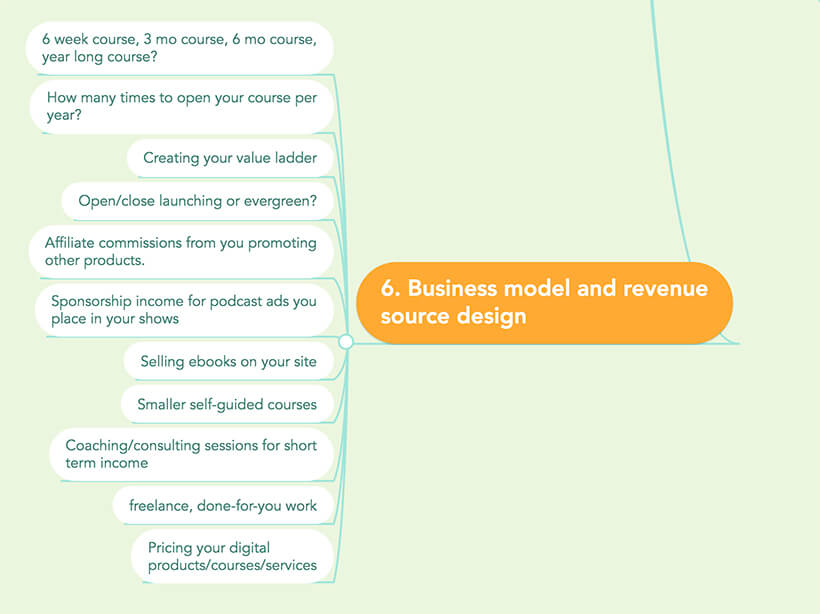
You have knowledge that can help people in your audience. After you’ve increased the traffic to your site and built up your email list, the question will then be “How do I earn money from doing the work of helping these folks?”
If you can help people with your ideas and knowledge, there are many ways to monetize that help.
The fastest, easiest way to get cash flow happening in the beginning, even while you’re building up your email list, is to offer coaching or consulting.
That’s an environment where you can immediately earn money for helping people with the problems you can help them solve, and you do it by helping them one at a time, in one-on-one, private sessions.
If you’re heading towards teaching people in an online course, this is where you can teach them one-on-one.
If you need to take the bootstrap path of funding the growth of the business yourself (and if you’re not sitting on a pile of savings you can use), this is the best way to start getting paid to share the knowledge you want to share, and help people make the change you want to help them make in their life.
Similarly, offering done-for-you services to help people with implementing the kind of change you’ll teach about in your knowledge products or consulting work is another potential source of short term income that can help you bootstrap the cost of building your business.
But there are other ways to make money from sharing your knowledge with the people in your target audience. Small digital products like ebooks or mini self-paced video courses that are less than $100 are a great next step on your value steps above free content.
Wait…value steps? Yes, think of a set of steps. The bottom step has your free content, your free “matter.” The next step up can have your first lower price point knowledge products, like the kind of small learning products I mentioned above.
The next step up could be one-on-one consulting with you for a bit more money. Eventually, when you have a flagship course, that can be the next step up on your value steps. And above that? Perhaps an exclusive small mastermind group that lasts for 6 or 12 months and costs $15,000 per person to join.
You can design your value ladder in many ways, but that’s the general concept. Each step higher has more value and is more expensive, and often, each higher step gives people more direct access, help, and support from you.
This is all part of designing your business model, as is crafting the way you structure your various online courses. For example, will your courses be 6 weeks long, 3 months long, 6 months long, a year long?
And how will you launch them? Will you open and close the registration for these courses a few times a year? Or once a year? Or will you leave them open for registration all the time, (which is called an evergreen launch model)?
Then, how will you price your courses? Will a given course cost $497, $997…or more? And what kind of payment plans will you offer people, if you offer them at all?
Outside of coaching/consulting, lower price point products, a flagship course, and mastermind groups, what other revenue streams can you add? Affiliate revenue is one great option to consider.
This is the scenario where you sign up as a referral partner, or affiliate, for products that you love and are already recommending to your people.
Then, through many different methods, you talk up your favorite things, your top picks, and whenever you talk about them, you link to the website where people can get your favorite things, whether they’re software apps or air filters or anything else.
When people click on your link, a cookie is set in their browser that will track whether or not they buy the thing you recommended to them, and if they end up
purchasing that product then, or at some point in the future, you’ll get credited for the sale and you’ll earn a small commission (which typically ranges between $7 and $200 per sale.)
Affiliate revenue is no joke. I’ve written blog posts that have made over $20,000 just from affiliate revenue that came as a result of me recommending something that I honestly loved and was recommending to my clients anyway.
Or, if you start podcasting and your podcast grows to the point where companies would be interested in marketing to your audience, you can make good extra revenue from placing ads in your podcasts that you read yourself. Those ads send traffic to their websites and some of your folks will buy what these companies are selling.
Rather than earning a commission for sales, you’ll get paid a set fee for putting the ad in your shows based on the number of downloads, or listens, your podcast episodes tend to get.
Course Curriculum Design and Course Content Creation

As you get closer and closer to the opening of any given course, you’ll need to map out and create the content for the course.
Most people who want to teach online for the first time tend to start the journey of building a business that sells knowledge products with this step. Then they will often skip the other towns and cities on the map I’ve shared with you here.
As I’ve mentioned above, skipping any one of these stops on the journey will cause big problems for you, but you can also create big problems for yourself by going to these places in the wrong order. It would be like flying to the Bahamas for vacation, and then realizing that you needed to pack your suitcases first.
As teachers we want to help people, and we want to do it by teaching. So it seems obvious to start with creating the actual content that will go in your first online course. But, honestly, it’s not the best place to start.
I’m right there with you. I love to teach and help people too. It’s what motivates me with the work I do here at Clarity Lab. But spending all of your time in the beginning of your journey creating your course content will make it harder on you to reach your financial goals, as well as your impact goals.
I know this will bring up questions of “when is the best time to start creating my course content?” The answer is part of a much bigger conversation…the “when to do which parts of this journey” conversation.
The full answer will have to wait for another ebook or blog post. In short though, I’d wait to start creating your content until after you’ve confirmed that the course you want to sell is something that the people in your market will pay money for. (And in order to confirm that you have to…wait for it…wait for it…know who the heck your products and services are for!)
And I’d wait until after your website is up and after you’ve started putting out regular helpful subject matter that’s drawing traffic to your site and building up your email list.
Why? Because building a relationship with a sizeable email list (anything above 2000 people is a great start) is the most important thing you can do to prepare yourself for financial success when you do eventually launch your first course.
When it’s time to create your course content though, you’ll need to spend time crafting the structure of your curriculum to create the best learning experience.
Now, I’m going to sound like I’m contradicting myself here, but, before you start talking to people in your market to see if they’d be interested in buying a course like the one you want to create, the one piece of your course that’s valuable to have is a simple outline of what the course will cover. Having an outline of the course content in your mind will help you explain to people what the course is about and how it will help them make a change in their life.
Beyond creating the outline of learning materials, you’ll need to decide on the best media format for each lesson. That will help you map out what kind of equipment you’ll need in order to create the lesson content, and who you’ll need to hire, if anyone, to help you create the content.
Aside from the the content itself, you’ll also need to plan out the full structure of the learning experience inside your course. This will eventually get translated to prospects on your website as deliverables…the “tangible” things they’ll get when they sign up for your course.
Will they get text lessons with videos, downloadable pdf worksheets, audio recordings, the ability to download all videos and audio recordings, access to one-on-one coaching sessions with you, access to a private online discussion forum or community area that’s just for member’s of the course?
All of those things will create the learning experience of people in your course, and fleshing out the offer of your course like that beyond just a series of lessons they could read through on their own will allow you to charge more for the course experience.
In particular, for example, whenever you can offer access to a vibrant community of other people in the course in in some form of an online community space, like a private Facebook group or private discussion forum that’s in your member’s area, the perceived value of your course will skyrocket.
Having access to you, as the main instructor, as well as a handful of teaching assistants and other members of the course, will bring 2.4 metric tons of value to the experience of learning inside your course.
The connection, support, and friendships that develop in the community area of your course can end up becoming the most valuable part of your course.
In my wife’s year-long course, which is called The Art of Money, we often have 30% to 40% of each year’s members sign up again for the following year of the course.
When we ask them why they chose to come back, the number one reason people say is that they came back because of the community and the support they get from my wife, her 5 teaching assistants, and the other course members.
So, it’s worth it to spend some time designing the full learning experience people will have inside your course, and if you can, consider offering a community space as part of the offer.
Launching Your Course
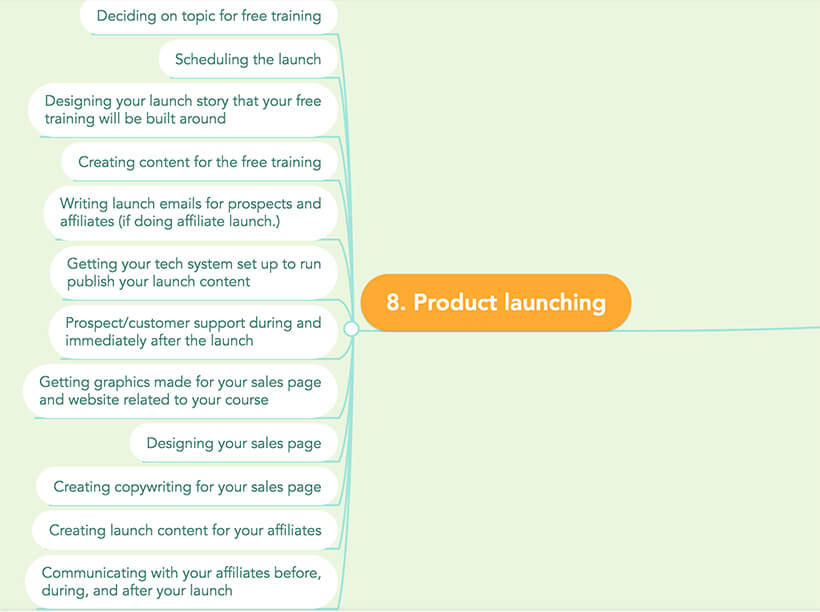
By the time you get to this part of the journey, you will have done an enormous amount of work. If you’re there already, congratulations. It’s no small feat to get to this place.
You found a niche of people to focus on and a problem they have that you can help them with. You’ve confirmed that the course you’re about to launch is something they want to buy. Your website is up with compelling copy on it, and you’ve been hard at work putting out free content to bring traffic to your site and build your email list with useful free offers for the folks coming to your site.
On top of that, you’ve started, or finished, creating your course content, and you’re ready to put it out into the world and let people sign up for it.
So now, the big question is, how do you go about marketing and selling your course?
That’s where product launching comes in.
I will tell you now, that if you’re new to all of this, your first instinct for how to do this will be like mine was when I was new to all this stuff: just send out a couple emails to my email list about the course being available to buy. That’s it.
But that approach? Is destined to fail every time.
The best, most successful way to launch a new program is to use a condensed version of your regular content marketing efforts (like your blog posts or free ebooks or free video course): to run a short free training series with around 3 or 4 pieces of extremely useful training content that then leads to the opening of your course.
Your course is then open for a short time, somewhere around a week, and then registration closes and your course begins.
This type of course launch was pioneered by Jeff Walker around 8 years ago, when he created this method of launching online courses and called it the Product Launch Formula.
He created his own online course of the same name that teaches this method of launching. I bought that course, used the method for my businesses, and have adapted that method with my wife for her business. It works amazingly well.
You’ve likely seen people using this product launch formula method to launch their courses before.
Designing your launch, coming up with your free training series content, creating that content, and creating all the emails that will announce each piece of content, all takes quite a bit of time.
When we prepare for an Art of Money launch (my wife’s year-long course), we start planning the launch out in mid summer and begin creating the content for the launch a couple months before the launch begins (which is normally in October of each year.)
There’s also a need to either write the email copy and sales page copy, or have that copy written for you by a skilled copywriter, and getting it formatted and loaded into your website and tech system in time for the launch.
Each piece of content is announced to your email list with an email (or a smaller “launch list” segment of your full list.) There’s a link in each email that leads people to the page on your site where the training material is, whether it’s text, video, or audio recordings.
Often times, people will need to opt in to the free training (which allows you to build your email list while you’re launching your program). You don’t have to require people to opt in to learn from your training though.
You’ll also need to make sure your tech system has the tools you need to run your free training series and then process payments for people who want to sign up for your course.
After their payment is processed, your system needs to create an account for them in your paid access members only area where your full course content will live.
That’s all just one possible workflow though. There are many, many ways to design and run your launch. You don’t actually need to follow anyone’s formula. We tend to do almost everything literally backwards from how Jeff Walker teaches his Product Launch Formula method, and it still works amazingly well.
I took Jeff’s PLF course years ago and became one of his top affiliates. It’s an amazing, powerful method. My point is simply that there are many ways to launch a course, so there’s room for creativity in how you do it.
Launching your course with some version of this model, where you put out a free training series and open your course for registration for a short period, then close it, is one of the most important, most powerful things you can do to create a sustainable income from selling knowledge online.
There is a tendency in all of us, me included, to want to put your course up for sale and leave it up…always…forever, so that people can sign up for it whenever they want.
That’s called an evergreen launch model. These can work, sometimes, but for the most part, I have rarely seen evergreen products do well. They can work, but there are some large challenges to making that model work.
The reason is that you’re up against human nature around purchasing things, particularly things that cost money, require time and effort, and require making changes in your life. Most online courses involve those three things.
If you don’t give people a reason to sign up for your course now, most of them will put it off.
They’ll wait until they think life will slow down a bit and they’ll have more time to do your course. Or they’ll wait until the kids are back in school. Or until winter break comes.
There will always be a reason not to buy your course if you leave it up for sale all the time, because they know it will be there when they come back….if they come back.
You’ll need to find a way to create a sense of authentic urgency for your prospects. To give them a reason to sign up for your course now, and get the benefits from it that can help them make the change you want to help them make in their life.
There are some downright icky, smarmy, aggressive ways to create a sense of urgency. It’s those kinds of tactics that have given online marketers a bad name. But we’re not all smarmy used car salesman, and you don’t need to be like that either if you want to make a good living teaching online.
There are, thankfully, ethical, respectful, even compassionate ways to launch your course while still creating a sense of urgency to help people not procrastinate and put off doing something that will help them.
Outside of the regular, ongoing work you’ll do to publish free, useful content on your website and social media channels, the work you’ll need to do around launching your course will be one of the biggest time and money expenditures that you’ll have.
And you’ll need to spend even more time preparing for and running your launch if you have a community of affiliates who will promote your course to their community, and in return, earn a commission for every person they send your way who buys your course.
This is called an affiliate launch, and when you do this, you’re essentially running two launches: one for the prospects in your audience, and another to your affiliates, since your affiliates will perform better when you’re highly engaged with them and cheering them on during the launch.
Like many topics in this map, affiliate launching is a whole other discussion, so for now, let’s keep going…
Building Your Team
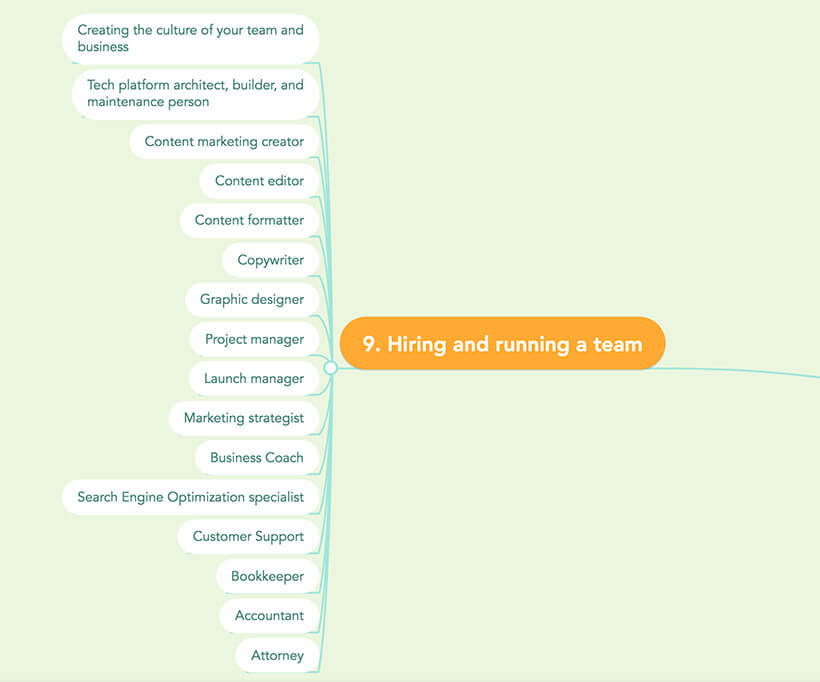
A big reason why I’m writing this ebook is to help give you some reality checks of what’s actually possible in terms of the kind of income you can make from selling your knowledge online, and how much work/time/money it takes to pull it off.
From the experiences I’ve had building several businesses that sell knowledge services and products, and from watching many others do the same thing, I can tell you that it will be very difficult for you to make much more than $100,000 per year by doing everything yourself.
And even then, getting to that level of income alone requires a huge amount of effort and time commitment. I know this because I’ve done it before. I’ve worn all of the hats, from tech guy to marketing strategist to copywriter to course instructor to customer support person (and the other 12 hats one needs to wear when doing such a thing), and it’s not easy by any stretch of the imagination.
I just about drove myself into the ground doing everything alone. It’s not healthy or enjoyable. Trust me.
If you want to grow to a six-figure income and beyond, you will absolutely need a team. They don’t need to be employees though. On paper, you can look like a one person business, but in reality, you’d have one or two or three (or a few more) contractors or freelancers that help you with the wearing of the 15 hats.
Who you need to hire and when you need to hire them is not an easy question to answer because of the number of variables involved. It really depends on what choices you make about how you’ll go about building and running your business, and when you choose to start working on the various things outlined in this ebook.
First though, let’s answer the “who?” question, which is more of a “what type of contractors/freelancers will I need to hire?” kind of a question (or, if you want to try wearing all the hats yourself, this is a “what kinds of hats will I need to wear” question.)
But here are the hats that need to be worn…by someone:
- Tech platform architect, builder, and maintenance person.
- Content marketing creator (blog posts, video blogs, podcast episodes, free courses, free ebooks, webinars, social media posts, etc.)
- Content editor (editing blog posts, videos, audio recordings, etc.)
- Content formatter (uploading and formatting blog posts, newsletters, videos, social media posts.) Copywriter (for copy on your website like the homepage, about page, sales pages for services/courses, copy for marketing emails, opt in copy for free offers on your site, copy for ads like Facebook ads.)
- Graphic designer (website design, social media content graphics, online course product graphics, sales page graphics.)
- Project manager (keeping an eye on all of the moving pieces, meeting deadlines, and various contractors who are doing work for the business.)
- Launch manager (managing the entire process of preparing for and running a launch for an online course, which is a large project in and of itself.) Marketing strategist (mapping out a plan for all of your online and offline marketing efforts for the coming year or two.)
- Business coach or consultant (strategic, tactical, psychological, and emotional support for your journey.)
- Search Engine Optimization specialist (planning out and implementing all of your SEO strategies and tactics.)
- Customer Support (handling emails from prospects and customers, mainstream media inquiries, podcast interview inquiries, handling failed and late payments from your customers.)
- Bookkeeper (tracking income and expenses for your business, generating monthly/yearly reports.)
- Accountant (handling the filing of taxes, mapping out tax strategy for an online business with very low overhead and not many write-offs.)
- Attorney (handling intellectual content protection, trademarking, copyright protection, business entity creation, and any other legal issue that comes up.)
Holy crap that’s a lot of hats! I know, I know…but that’s what it takes to build and run a business like this. And that’s why I highly recommend that you don’t try to do it all yourself. Do. Not. Wear. All. The. Hats.
As soon as you can, start building your team. If you’re building a brand new business from scratch, the first people you’ll want to hire are a tech person, a website/graphic designer, a copywriter, and a virtual assistant. A good VA can wear a bunch of the hats on the list above.
How big does your team need to be? Not very. To run a business that makes mid six-figures a year from selling an online course, we need a 4 person team, plus a few other contractors that we use once or twice a year (like a graphic designer, our accountant, and our attorney.)
Personal Growth and Health
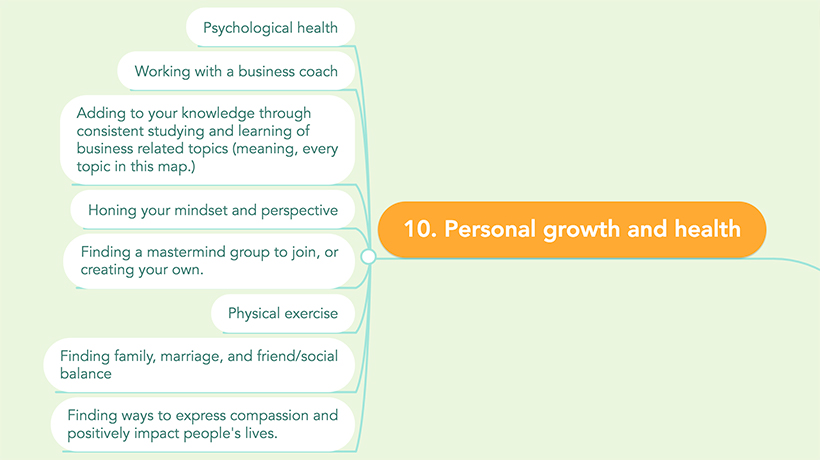
Building and running a business like this is path of personal, and even spiritual, growth. It will push you to your limits and give you plenty of challenges that can help you grow beyond those limits.
That means that you’ll have the opportunity to not only design a lifestyle you want to live with a business like this, but to use it as a life practice, or an area of life where you can grow into a better version of yourself.
Personally, I use the path of running a business like this as a way to also express compassion and make a positive impact in the world.
For 20 years of my life I was a dedicated Buddhist student and practitioner who meditated an hour every day, without fail, for years on end.
About 12 years ago, when my wife became pregnant with our son, I was suddenly faced with a large need to figure out how to make more money. And that’s precisely when my entrepreneurial path began.
Though I don’t meditate an hour a day anymore, and I’m not actively studying Buddhist texts, I still practice. My path is that of the impact entrepreneur. I have similar goals from my Buddhist days, but they’re now implemented in a different arena.
My desire to help people by reducing their suffering is still very strong, but I now take action to make that happen in the online business realm. I help people like you, who want to help other people improve their lives in some way.
I’m sharing my own perspective on this to simply show you that though this path of the online entrepreneur will take a lot of time, energy, effort, and potentially money as well, you can use it as a personal growth path too. It can help you grow into a better version of yourself, if that’s something you’re interested in.
Having walked this path myself for the last 12 years, and watching my wife walk it as well, there’s an enormous opportunity to make a lasting impact in people’s lives through this kind of business.
But this work does take its toll. You’ll need to work hard on keeping your life in balance. Time with your spouse/significant other, children, friends, or time alone…you’ll need to focus on creating time for those things, or your business will quickly eat up all of your time.
The same goes for your physical health. Running an online business will mean that you’ll need to spend a lot of time sitting at your computer, or, sitting with your computer on your lap. Either way, it’s a lot of sitting and focusing on a backlit screen, and a lot of typing.
I’m a big fan of road cycling and racing bikes and am on my bike training hard for an hour and a half a day 5 or 6 days a week. I’ve found that that’s the only way I can manage to sustain the amount of focus it takes for me to run an online business.
The bottom line is that if you’re attracted to building a business like this, and living the lifestyle that comes with it, you’ll have to be very careful to create boundaries and balance in your life. Because you can work from home, or your kitchen table, or your bed, your business can easily take over every available hour of your time in a given day. There’s always more you could do. The “to do” lists will never, ever disappear.
And even though you might hire a team to help you wear all those hats, you’ll still need to have a love of learning new things so you can stay on top of the latest trends in each of the areas involved in running your business.
Always learn, and keep learning.
Lastly, because this path of the online entrepreneur is not an easy one, you’ll need emotional and psychological support along the way. Sure, you can go for a while without this kind of support, but eventually, the burdens will become too great for you to bear alone.
Working with a business coach who provides emotional and psychological support can be crucial, as can becoming part of a free or paid mastermind group. A group like that gives you a space where you can receive support and advice from other online entrepreneurs who are at a similar stage of the journey as you, and it also gives you a space to give support to others, which is often more beneficial to you than receiving direct support for your own challenges.
I’ve been in a small, unpaid mastermind group with a group of 3 other people for the last 4 years. We tend to meet every two weeks for an hour or two to support each other with each of our businesses. That group, and their support, has been invaluable to me on my own journey.
If you’ve made it to this part of the ebook, you’re likely getting the sense that building and running an online business that sells help in the form of knowledge products or services is not easy. Well…it’s not.
This is why I get so frustrated when I see other business owners teaching people how to build a business like this and they make it seem like this is all super easy. Like “all you have to do is build a big following on social media and you too can start earning a six figure income in six weeks.” Blech. That kind of thing is just flat out bullshit.
Building something like this is HARD. There’s no way to sugar coat it if I’m going to be completely honest about it. The income potential and the lifestyle potential are definitely real. Like super real. Don’t get me wrong. It’s absolutely amazing to be able to work from wherever you want, on a schedule you choose, and to only need electricity, your laptop, and a good internet connection to run your business.
Creating this kind of lifestyle for yourself is definitely worth it, but it isn’t easy. Here’s the thing though: there aren’t any easy paths to earning money and making a positive impact in the world. All options involve some flavor of hard. This business model, or that one, or working for a company or an organization…they’re all hard in their own ways. But remember: at least you get to pick your flavor of hard.
So, if all of your options involve hard things, why not choose one that also gives you a lot of freedom and control over your life? Yes. Exactly. Choose your own adventure. Build a business that you have control over so you can design a life that you want to live, a life you can look back on when you’re old and feel 100% satisfied with.
The End of the Beginning
Okay. Seriously, if you’ve read this far, you 1) have a lot of stamina, and 2) are super awesome.
I hope you’ve found a great deal of clarity and help within this ebook. I know it’s a lot to take in, I know you probably have 147 questions floating around in your mind, and I know this is all just a map, which can only give you a high level view of the terrain ahead of you on the journey.
But I haven’t yet seen a good map like this out there on the interwebs yet, so I thought I’d create one for you, and then tell you about the places you’ll need to travel to to make your dream for your business and lifestyle a reality.
You’ll likely be left with a lot of questions around how the heck to do all of the things I’ve talked about in this tour of the map. I don’t want to leave you hanging with a ton of questions, but a) you at least now have a detailed map of what it takes to create a business like this and b) in order to answer your questions, I’ll need to create more subject matter for you 🙂
If you’re interested in more immediate, direct help, you can hire me and literally rent my mind to focus 100% on helping you, one-on-one, to map out a plan to build and grow your specific super awesome business.
If that sounds interesting, just click here to read about my consulting services. Consulting sessions with me are pretty much like getting together for coffee at a cafe and cranking on a plan for the next set of things to do in order to build the dream of your business.
And please, keep going towards your dream. The people in your tribe need you to share your knowledge so they can make the change they want to make in their lives.
All the best to you,
~Forest Linden


Forest Linden has written a detailed and practical guide appropriately entitled “The Ultimate Online Business Navigation Map”.
The use of a mind map is a creative way to clarify the evident complexity and anticipate the many challenges facing even the most intrepid knowledge navigator.
In the Table of Contents 14 topics document the edupreneurial venture:
1. Introduction, 3
2. Your Opportunity, 5
3. The Online Biz Map, 9
4. First Things First, 12
5. Building Your Brand, 15
6. Building your Website Tech System, 17
7. The Power of God Copywriting, 25
8. Your marketing Engine, 28
9. Choosing Your Business Model, 33
10. Course Curriculum, 37
11. Launching Your Course, 41
12. Building Your Team, 47
13. Business as a Personal Growth Path, 52
14. The End of the Beginning, 57
Three things are needed for success in this endeavor – experience, education and the decision to embark upon the journey.
This Navigation Map from ClarityLab provides the first two . The third is up to us.